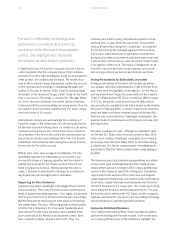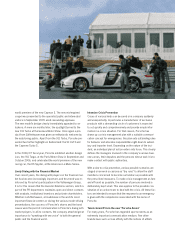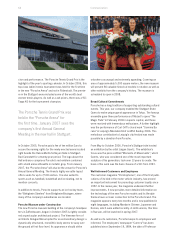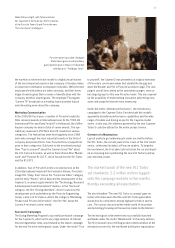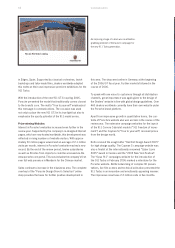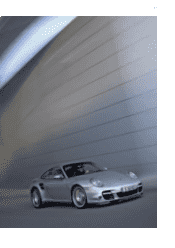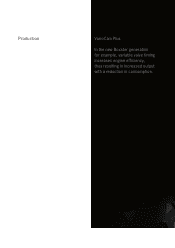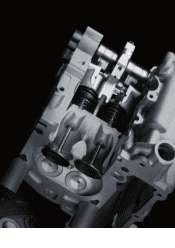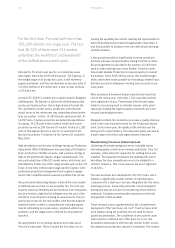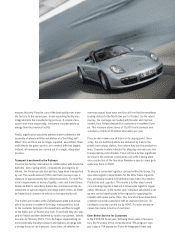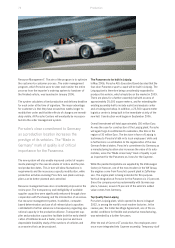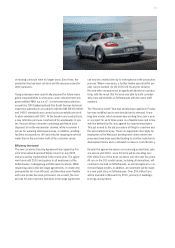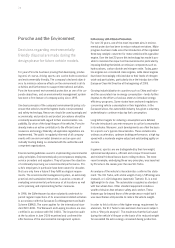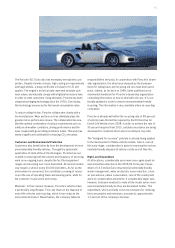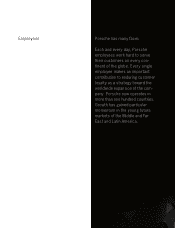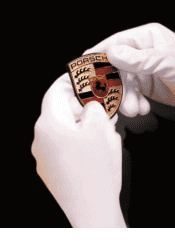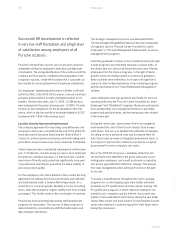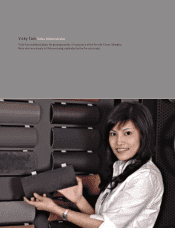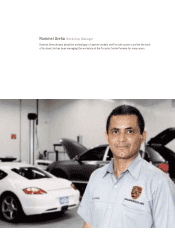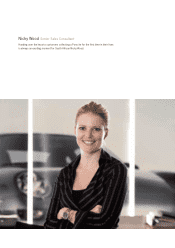Porsche 2005 Annual Report Download - page 74
Download and view the complete annual report
Please find page 74 of the 2005 Porsche annual report below. You can navigate through the pages in the report by either clicking on the pages listed below, or by using the keyword search tool below to find specific information within the annual report.
72
Resource Management”. The aim of the program is to optimize
the customer-to-customer process. The order management
program, which Porsche uses to steer and monitor the entire
process from the importer’s ordering system to handover of
the finished vehicle, was launched in January 2006.
The system calculates a fixed production and delivery deadline
for each order at the time of signature. The major advantage
for customers is that they have around two weeks longer to
modify their order and that the effects of changes are immedi-
ately visible. All Porsche Centers will eventually be incorpora-
ted into the order management system.
Porsche’s clear commitment to Germany
as a production location increases the
prestige of its vehicles. The “Made in
Germany” mark of quality is of critical
importance for the Panamera.
The new system will also enable improved control of require-
ments planning for the overall volume of orders and the plan-
ned production dates. This in turn will allow fluctuations in
requirements and the necessary capacity modification, while
production activities involving Porsche’s own plants and sup-
pliers can be better planned and controlled.
Resource management was also considerably improved in the
review year. The transparency and intelligibility of available
supplier capacities were significantly enhanced through close
cooperation with Purchasing and the introduction of an innova-
tive resource management system. In addition, computer-
based determination and use of all relevant plant capacities
contributed to further advances in transparency regarding ope-
rational capacity in the production alliance. Transparent sup-
plier and production capacities facilitate both the early identifi-
cation of bottlenecks and a faster, more precise and more
dependable feasibility study of the numbers of vehicles and
accessories that can be produced.
The Panamera to be built in Leipzig
In May 2006, Porsche AG’s Executive Board decided that the
four-door Panamera sports coupé will be built in Leipzig. The
Leipzig plant is therefore being considerably expanded to
produce this vehicle, which should be on the market in 2009.
There are plans for a further assembly hall with an area of
approximately 25,000 square meters, and for extending the
existing assembly hall to include a pilot and analysis center
and a training workshop. In addition, a 23,500-square-meter
logistics center is being built in the immediate vicinity of the
new hall. Construction work began in September 2006.
Overall investment will total approximately 150 million Euro.
As was the case for construction of the Leipzig plant, Porsche
will again forgo its entitlement to subsidies, this time in the
region of 30 million Euro. The decision in favor of Leipzig is
testimony to Porsche’s faith in its local employees’ skills and
is furthermore a contribution to the regeneration of the new
German Federal states. Porsche’s commitment to Germany as
a manufacturing location also increases the value of its auto-
mobiles, since the “Made in Germany” mark of quality is just
as important for the Panamera as it was for the Cayenne.
While the painted bodyshells are supplied by the Volkswagen
factory in Hanover, one of the most modern in the VW Group,
the engines come from Porsche’s parent plant in Zuffenhau-
sen. The engine plant is being extended for this purpose.
Vertical integration at Porsche for the Panamera is 15 percent.
Since the company works predominantly with German sup-
pliers, however, around 70 percent of the vehicle’s added
value comes from Germany.
Top Quality from Leipzig
Porsche’s Leipzig plant, which opened its doors in August
2002, is among the world’s most modern factories. In the
review year, the Collective Wage Agreement, one of the es-
sential conditions for flexible and productive manufacturing,
was extended by a further five years.
After the end of Carrera GT production, the employees were
once more integrated into Cayenne assembly. Temporary staff
Production


